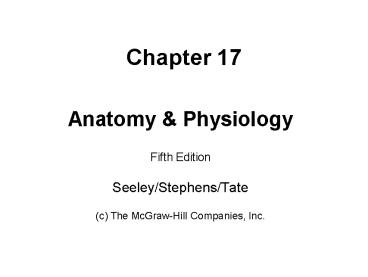Anatomy - PowerPoint PPT Presentation
1 / 26
Title:
Anatomy
Description:
Title: Chapter 17 Subject: Anatomy & Physiology, 5e Author: Seeley/Stephens/Tate Last modified by: Curtis Greene Created Date: 7/27/1999 3:40:43 PM – PowerPoint PPT presentation
Number of Views:114
Avg rating:3.0/5.0
Title: Anatomy
1
Chapter 17
- Anatomy Physiology
- Fifth Edition
- Seeley/Stephens/Tate
- (c) The McGraw-Hill Companies, Inc.
2
FUNCTIONAL ORGANIZATION OF THE ENDOCRINE SYSTEM
- There are two major means of communication in the
body the neuronal system and the endocrine
system. - The neuronal system has clear pathways which
are connected with neurons. Thus it is reasonably
clear for each neuron where it starts and where
it ends. (reflex --- cerebral cortex ----
targets) - At the end knob, neurotransmitters are released.
- Its complexity makes it possible to stimulate
more than one tissue and organ simultaneously. - The effect is relatively short lived.
3
- The endocrine system the active substances,
hormones, are made in specific organs. - The glands may be stimulated with neurons.
- Hormones have target tissue and organs.
- Long distance transport of its active substance
is done by the circulatory system. - Local effect is also possible.
- Again, one hormone may effect more than one
target organs. - The effects are usually slow and relatively long
lasting.
4
- An overview
- The word endocrine is in contrast with exocrine.
Thus we are concerned with internal secretion. - Endocrine glands secrete specific hormones.
- The strength of a hormone is determined by its
concentration, while the strength for neurons is
often the frequency of the action potential. - Also recall the neurohormones may be released by
neurons into the circulatory system. - Functional classification of chemical signals is
shown in Fig. 17.1
5
(No Transcript)
6
(No Transcript)
7
- Review Table 17.1
- Autocrine chemical signals released by cells
and have a local effect of the same cell type.
Example are prostaglandins and platelets. - Paracrine chemical signals released by cells
and effect local other cell types. Somatostatin
from pancreas. - Pheromones hormones secreted into environment.
8
- Structure of hormone there are type major
types. - Amino acid derivates epinephrine,
norepinephrine, the thyroid hormones, pineal
hormone (melatonin) - Peptide/protein hormone antidiuretic hormone,
glucagon, oxytocin, growth hormone, prolactin,
insulin. - Lipid derivatives
- Steroid hormones estrogens, testosterone
- Prostaglandins derived from arachidonic acid.
9
(No Transcript)
10
- Control of secretion rate
- In essence the control is in a form of negative
feedback. - Three major patterns
- By other substance such as sugar controls the
regulation of insulin release. - Increased blood sugar
- Stimulates insulin release from the pancreas
- Insulin stimulates glucose uptake by tissues
- Decrease in blood sugar
11
(No Transcript)
12
- Neuronal control of endocrine glands
- Stress or exercise stimulates sympathetic
division of ANS. - Release of epinephrine or smaller amounts of
norepinephrine from the adrenal medulla.
(Fig.17.5) - Regulation of hormone secretion by another
hormone - Thyroid-releasing hormone (TRH) is released from
neurons in the hypothalamus. - TRH stimulates the release of thyroid stimulating
hormone (TSH) from the anterior pituitary gland. - TSH stimulates the secretion of thyroid hormones
from the thyroid gland. - Thyroid hormone stimulates tissues
- That includes the hypothalamus and the anterior
pituitary (negative-feedback) to inhibit both TRH
and TSH.(fig.17.6) - Regulation is usually complex and more than one
factor could affect organs. For example, the
level of insulin may be regulated by blood
glucose and ANS., Ex of positive feedback. (fig
17.7)
13
(No Transcript)
14
(No Transcript)
15
(No Transcript)
16
- The level of hormone in the blood steam may
- Maybe relatively short
- May respond in a matter of hours
- May respond in a matter of days
17
(No Transcript)
18
- Transport
- Hormones are transported through the circulatory
system dissolved in plasma. - At the target sites they diffuse out from the
capillaries. - Some hormones such as, steroids and thyroid
hormones, are bound to specific plasma proteins
reversibly. - hormone plasma protein hormone-protein
- While this equilibrium is held in plasma, there
are free hormones and proteins bound hormones. - Free hormones may diffuse out through the walls
of capillary pores at the target sites, while
proteins bound hormones remain within the
capillaries. But eventually they will establish a
new equilibrium (carry more hormone) and make
more free hormones available (sustained release).
19
(No Transcript)
20
(No Transcript)
21
(No Transcript)
22
- Metabolism and Excretion
- Once hormones are poured into the blood steam, it
is equally important to excrete them from the
circulation to avoid excessively long effects of
hormones. - The lengths of time it takes for elimination by
half is called half-life time. - The half-life time of water soluble hormones,
such as proteins, glycoproteins, epinephrine and
norepinephrine, is relatively short. - The half-life time of lipid soluble hormones,
such as steroid and thyroid hormones, is longer.
23
- As shown in Table 17.3 hormones are eliminated
from the circulatory system in four ways - Excretion
- Kidneys-urine the liver-bile
- Metabolism
- Enzymatic digestion
- Active transport
- Recycling (neurotransmitters)
- Conjugation
- Sulfate and glucuronic acid groups bind to
hormones and they are released into urine or bile.
24
- Interaction of hormones with their target tissues
- At their designated sites hormones interact with
the target cells and active their intrinsic
function, usually stimulating specific enzymes. - Hormone receptors protein or glycoprotein.
- Each target cell has a specific binding site for
the specific hormone. - However, a hormone may bind to the/ other target
receptor which are similar. - After prolonged exposure to a hormone, the tagged
cells may reduce the number of hormone receptors
called, down regulation. - On the other hand, exposure to stimulation may
increase the number of hormone receptors called,
up-regulation. Example is LH receptors are up
regulated by FSH.
25
(No Transcript)
26
The End.































